The final event of the Innovation Leaders Club season – from idea to spin-off
Just before Midsummer’s Day, an information session was held in Tallinn’s Arhitektuurikatel for the Innovation Leaders Club season. Speakers from Enefit, SEB, Net Group, and Accelerate Estonia spoke on the basis of experience on the following topics: how to develop ideas within the company, how to collect and evaluate ideas, how to create an idea bank and how to get from idea to spin-off? The day was moderated by Anette Ustal, Head of SEB Tallinn Innovation Center.
Kadi Steinberg from Enefit Idea Hub spoke about the energy company’s experience in developing and testing ideas with customers. The idea of the company Idea Hub started so that the development of new ideas into business could be done systematically. “Operating a business is about solving everyday questions on a running basis – but who delivers ideas?” Kadi Steinberg spoke about the early days of IdeaHub. “In the beginning, only a few people were involved, today it has grown to 100+ people working on ideas.”
1400 ideas – 40 million euros of added value

In summary, IdeaHub’s focus is on acquiring an idea based on new business models and/or competencies, and validating and developing the business case until it reaches a functioning business case.
In total, IdeaHub has gathered 1,400 ideas, 56 of which have reached the implementation stage. According to Steinberg, the value generated through it is EUR 40 million.
Innovation goes hand in hand with customers
While in the early days of IdeaHub the main emphasis was on discovery, in recent years the development of business cases with customers includes solution validation, piloting, business and financial modeling, design blueprints, accelerators, involvement of the expert community both within the parent company Eesti Energia and among researchers. The innovation teams are put together across business units – this allows the idea to be developed from start to finish, and cross-team teams have also helped to make teams work better together, according to Steinberg.
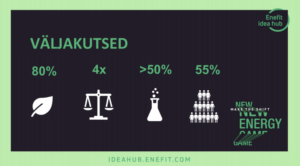
“In the big picture, we interpret our activities from the group’s strategy. Eesti Energia’s ambition is, on the one hand, to offer customers convenient and useful energy solutions, and, on the other hand, to move towards ever greener energy. We follow these guidelines and look for ideas there,” said Steinberg. He also set an ambitious target of 80% of energy production coming from green technology by 2050.
Field expert ≠ customer experience expert
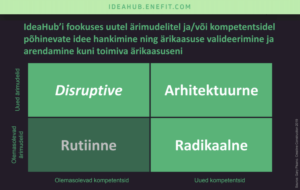
According to Kadi Steinberg, companies tend to deliver too much within their bubble. As part of the Enefit Energy Pitch competition, the idea was to make the customer subscription agreement better. The people in house were surprised by this, because “our process is so simple, one-two-three-four steps and everything is clear to the client and the connection has been made!” Nevertheless, the idea was validated on the clients, and when the client interviews on the last day revealed that nothing was understood throughout the joining process, the people in their house also realized that an expert in the field is not always an expert in an excellent client experience.
Creating a competitive advantage for the Estonian economy through innovation
Mikk Vainik, head of Accelerate Estonia, told the club members why the program was created – to create a competitive advantage for the Estonian economy. Vainik himself has a long-term background as a civil servant, about a decade ago he started developing research policy, then dealt with state information systems, and the last few years have gone to developing financial instruments and a startup ecosystem. Due to all this, Vainik became more interested in public sector innovation.
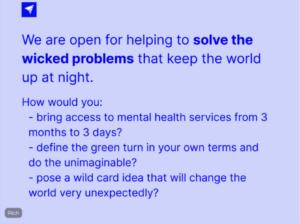
Lots of hacking, little to show
Vainik recalled a couple of public sector hackathons. In 2016, a Policy Hack was held at the request of the European Commission, which was attended by top investors and startup founders. “It simply came to our notice then. I decided that we would do better, already a year later, when Estonia held the presidency of the European Union.”
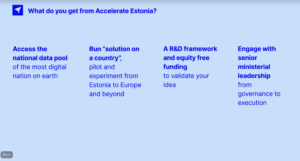
Vainik chose various policy makers from Mexico to Thailand in Policy Hack who had developed startup ecosystems. “We did preliminary work with them, we offered support. When it was over, I asked again what would happen to the Dutch scaleup initiative, for example. It turned out that the concern was that the team did not know how to sell their ideas to the ministers.”
Vainik understood that we had to return to the drawing board again and make public sector innovation work in Estonia. This is exactly how Accelerate Estonia was born in 2019.
Why are we solving the problems of London expats?
“According to Index Ventures, Estonia ranks first in the world in terms of startup regulation. Great! But why do we use it to solve the problems of London expats? Why not solve our people’s problems here?”
Vainik also said that although e-Residency is a good example of public sector innovation, its success did not work for officials, because it did not solve anyone’s daily crises.
Accelerate Estonia collects ideas within the public sector and then finds a team in the private sector to validate any solutions to them. According to Vainiku, it is important for such an approach that these teams are not connected with years of legacy, which often sets boundaries as to why nothing can be done.
75 ideas – more like vitamins than pain relievers
Vainik wanted to ensure the success of the Accelerate Estonia program and therefore visited the secretaries of all the ministries. “Many were a little arrogant in the first few minutes, but by the end of the meeting, the majority admitted that they could benefit from the program.”

In the first year, the program gathered 75 ideas. Their viability was tested on the Chancellors, because in the end they should implement them or ensure their implementation. The chancellors gave the green light to 17 ideas. They, in turn, were further developed, and then the idea came to pitch them to a jury of officials. Unfortunately, most of them turned out to be more like vitamins than pain relievers. However, two ideas continue to this day.
To make something better for everyone
Vainik says that the main idea of the Accelerate Estonia program is to create new markets. “Not that a startup or scaleup comes and uses us to create a new business direction or sell something to the state, but to make something better for all market participants.”
This year’s focus is on mental health and going green, and three teams are already working on the topics – all thanks to R&D grants, and the ideas to be developed go through a 3-step filter: first with the Accelerate Estonia team in cooperation with Tehnopol; the second step is validated by officials; and the third step involves a mission council from the administration, the private sector, the third sector, and the academy.
“When I started reading about the experience of innovation laboratories in other governments during the progra, I saw that it took an average of three years to run such a process. And there was also a suggestion that the measure of the startup period could be the number of projects we can run during that period.”
Does the strategy drive innovation or vice versa?
Andra Aaltoa, head of SEB Baltic Strategy and Customer Experience, said that SEB had an idea bank 10+ years ago. “People could send thoughts about the bank’s services, what was wrong or should be done better, and then someone started processing those ideas. However, this resulted in product owners trying to say that these ideas were meaningless, unfeasible, or already being implemented. We realized that the idea is good, but the process around it must be different and help to bring the ideas to fruition.”
From there, the bank came up with the Employee Lab concept, which ran until 2018, and from there another concept. The bank itself underwent a major change and development resources were also tied up, which also hindered the implementation of ideas,” Aaltoa recalled.
Aaltoa shared the harsh truth: “Innovation also needs discipline!” According to Aaltoa, failures must be tolerated, but incompetence must not be permitted. One must experiment, but in a controlled way. “Once we had a situation where no pilot project failed,” Aaltoa recalled with a laugh.
The digital divide in society is growing, but there are also people who are hyper-aware and aware of what is happening in the world and what customers need. “If there are more such people, there is hope that in the long run that competition will survive,” Aaltoa summed up her presentation.
Building spin-offs is as “glamorous” as curling
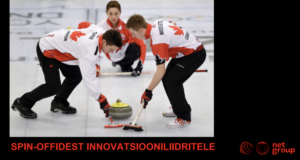
“Building spin-offs is really like curling or like the rather non-glamorous launching of an aircraft from its mothership,” Siim Lepisk, Net Group’s innovation manager, said in relating his experience.
Net Group spin-offs
Synerall’s customer and invoice management software is a spin-off of Net Group, which has two million customers in Finland.
Depowise is a spin-off that delivers to the Swedish market and was launched thanks to a Swedish investment fund that came to Net Group’s attention about how to build its systems in a way that would keep them compliant with regulations for years to come. “We made them a system that is future-proof and we were able to sell it to a Swedish bank, which all investment funds use. In essence, it is a compliance tool that helps to keep investors informed that they are not doing anything other than what is promised with the money they are investing,” said Lepisk.

Schoolaby is a spin-off in the making. “We essentially produced an e-school bag. Many people know and use Google Classroom, but there are many that can’t be customized or modified. Schoolaby allows you to design a user family in one environment. There is also an analytical tool that shows which materials the children benefited from. Based on this input, completely individual curricula can be developed. Schoolaby makes teachers ‘lives easier and students’ lives better,” commented Siim Lepisk. As of now, Schoolaby has several dozen Estonian school clients and negotiations are also underway with schools on the African continent.
Also in its pilot phase, Net Group has built a private sector storytelling robot to find customers and applications in the private sector.
Spin-off funnel
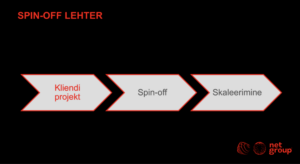
Lepisk said that Net Group’s ambition is to help one spin-off company get on the market every year. And he added that in fact this ambition is even bigger – to achieve one unicorn a year.
If Arvo Pärt would like it, it’s probably a good idea
The final event of the ILK season ended with a discussion panel on the topic “How to get from idea to implementation” – with the participation of Siim Lepisku, Kadi Steinberg and Mikk Vainik. The panel was moderated by Anette Ustal.
“The project’s structure and time frame force us to move forward. If the project is strategic, then the structure and deadline will help to implement it,” said Siim Lepisk.
Mikk Vainik shared his experience that teams that have worked together before should be included in the innovation program and then mixed as little as possible.
Kadi Steinberg said that it is important to push people out of their comfort zone and make them communicate with potential customers immediately. “Customers are actually happy to come along and communicate.” In addition, Steinberg emphasized that people’s own profile is also important. “There is a lot of uncertainty about innovation and it requires flexibility.”
Siim Lepisk also gave a recommendation on how to avoid burning money. “Any network of partners helps to avoid unnecessary things. Of course, the teams may be very worried that the webpage is not ready yet, there are some bugs, but if the partners are reliable, this won’t interfere with achieving your goals. ”
Kadi Steinberg emphasized the importance of having management involved at a very early stage. “Leaders should be involved from the beginning, because their support is crucial.”
As a point of the discussion panel and the event, Anette Ustal asked the participants to share one trick or vital lesson that would ensure the successful implementation of an idea. What to do, what to avoid?
Siim Lepisk: “Get out of the house now and ask people why it doesn’t work, what to do differently? Not every feedback can be employed, but you can get a fresh perspective.”
Kadi Steinberg: “Involve customers in validating your ideas! In addition, people who innovate should be open-minded.”
Mikk Vainik: “There must be a mandate. I once asked the Ministry of Culture how they validate ideas before implementing them, and I was told that if Arvo Pärt would like it, it’s probably good and worth implementing.”

